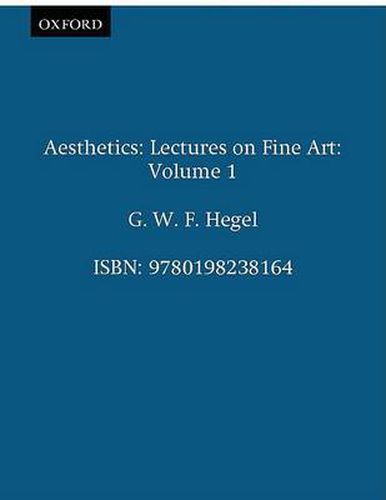Readings Newsletter
Become a Readings Member to make your shopping experience even easier.
Sign in or sign up for free!
You’re not far away from qualifying for FREE standard shipping within Australia
You’ve qualified for FREE standard shipping within Australia
The cart is loading…






In his Aesthetics Hegel gives full expression to his seminal theory of art. He surveys the history of art from ancient India, Egypt, and Greece through to the Romantic movement of his own time, criticizes major works, and probes their meaning and significance; his rich array of examples gives broad scope for his judgement and makes vivid his exposition of his theory. The substantial Introduction is Hegel’s best exposition of his general philosophy of art, and provides the ideal way into his Aesthetics. In Part I he considers the general nature of art: he distinguishes art, as a spiritual experience, from religion and philosophy; he discusses the beauty of art and differentiates it from the beauty of nature; and he examines artistic genius and originality. Part II provides a sort of history of art, divded into three periods called Symbolic (India, Persia, Egypt), Classical (Greece), and Romantic (medieval and post-medieval up to the end of the eighteenth century). Part III deals individually with architecture, scuplture, painting, music, and literature.
$9.00 standard shipping within Australia
FREE standard shipping within Australia for orders over $100.00
Express & International shipping calculated at checkout
In his Aesthetics Hegel gives full expression to his seminal theory of art. He surveys the history of art from ancient India, Egypt, and Greece through to the Romantic movement of his own time, criticizes major works, and probes their meaning and significance; his rich array of examples gives broad scope for his judgement and makes vivid his exposition of his theory. The substantial Introduction is Hegel’s best exposition of his general philosophy of art, and provides the ideal way into his Aesthetics. In Part I he considers the general nature of art: he distinguishes art, as a spiritual experience, from religion and philosophy; he discusses the beauty of art and differentiates it from the beauty of nature; and he examines artistic genius and originality. Part II provides a sort of history of art, divded into three periods called Symbolic (India, Persia, Egypt), Classical (Greece), and Romantic (medieval and post-medieval up to the end of the eighteenth century). Part III deals individually with architecture, scuplture, painting, music, and literature.